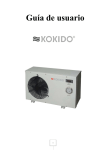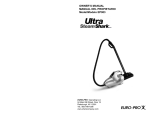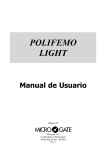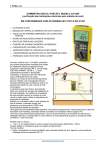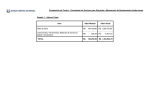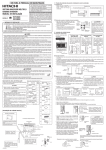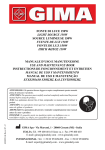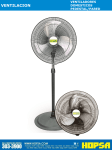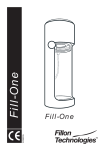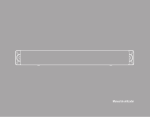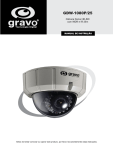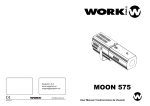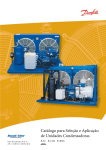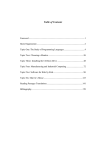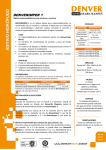Download Service Manual 05/2004
Transcript
® BOTTLE COOLERS COR9530UBCST Service Manual Release Date: May, 2004 Publication Number: 630460279SER Revision Date: NA Revision: A Visit the IMI Cornelius web site at www.cornelius.com for all your Literature needs. SERVICE MANUAL The products, technical information, and instructions contained in this manual are subject to change without notice. These instructions are not intended to cover all details or variations of the equipment, nor to provide for every possible contingency in the installation, operation or maintenance of this equipment. This manual assumes that the person(s) working on the equipment have been trained and are skilled in working with electrical, plumbing, pneumatic, and mechanical equipment. It is assumed that appropriate safety precautions are taken and that all local safety and construction requirements are being met, in addition to the information contained in this manual. To inquire about current revisions of this and other documentation or for assistance with any Cornelius product contact: www.cornelius.com 800-238-3600 Trademarks and copyrights: Aurora, Cornelius, Decade, Hydro Boost, Sitco, Spirit, UF-1, Vanguard, Venture, Olympus, and Vista are registered trademarks of IMI Cornelius Inc. Optifill trademark is pending. This document contains proprietary information and it may not be reproduced in any way without permission from Cornelius. Printed in U.S.A. Copyright © 2004, All Rights Reserved, IMI Cornelius, Inc. COR9530UBCST Service Manual TABLE OF CONTENTS Table of Contents . . . . . . . . . . . . . . . . . . . . . . . . . . . . . . . . . . . . . . . . . . . . . . . . . . . . . . i English . . . . . . . . . . . . . . . . . . . . . . . . . . . . . . . . . . . . . . . . . . . . . . . . . . . . . . . . . . . . . . Features of the Unit . . . . . . . . . . . . . . . . . . . . . . . . . . . . . . . . . . . . . . . . . . . . . . . . . Refrigeration System . . . . . . . . . . . . . . . . . . . . . . . . . . . . . . . . . . . . . . . . . . . . . . . . . Description of its components . . . . . . . . . . . . . . . . . . . . . . . . . . . . . . . . . . . . . . . The Refrigeration Cycle . . . . . . . . . . . . . . . . . . . . . . . . . . . . . . . . . . . . . . . . . . . . . . Electrical Wiring . . . . . . . . . . . . . . . . . . . . . . . . . . . . . . . . . . . . . . . . . . . . . . . . . . . . Cleaning and Preventive Maintenance . . . . . . . . . . . . . . . . . . . . . . . . . . . . . . . . . . . Condensate Disposal System . . . . . . . . . . . . . . . . . . . . . . . . . . . . . . . . . . . . . . . . . . Troubleshooting . . . . . . . . . . . . . . . . . . . . . . . . . . . . . . . . . . . . . . . . . . . . . . . . . . . . Possible causes and solutions . . . . . . . . . . . . . . . . . . . . . . . . . . . . . . . . . . . . . . 1 1 1 1 2 4 5 5 6 6 Español . . . . . . . . . . . . . . . . . . . . . . . . . . . . . . . . . . . . . . . . . . . . . . . . . . . . . . . . . . . . . 9 Caracteristicas del equipo . . . . . . . . . . . . . . . . . . . . . . . . . . . . . . . . . . . . . . . . . . . . . 9 Sistema de Refrigeracion . . . . . . . . . . . . . . . . . . . . . . . . . . . . . . . . . . . . . . . . . . . . . 9 Explicación de los componentes . . . . . . . . . . . . . . . . . . . . . . . . . . . . . . . . . . . . . 9 El Ciclo de Refrigeracion . . . . . . . . . . . . . . . . . . . . . . . . . . . . . . . . . . . . . . . . . . . . . 11 Diagrama eléctrico . . . . . . . . . . . . . . . . . . . . . . . . . . . . . . . . . . . . . . . . . . . . . . . . . 12 Limpieza y Mantenimiento Preventivo . . . . . . . . . . . . . . . . . . . . . . . . . . . . . . . . . . 13 Sistema de Recolección de Condensado . . . . . . . . . . . . . . . . . . . . . . . . . . . . . . . . 13 Principales Problemas del Refrigerador . . . . . . . . . . . . . . . . . . . . . . . . . . . . . . . . . 14 Posibles causas y soluciones . . . . . . . . . . . . . . . . . . . . . . . . . . . . . . . . . . . . . . 14 © 2004, IMI Cornelius Inc. -i- Publication Number: 630460279SER COR9530UBCST Service Manual Publication Number: 630460279SER - ii - © 2004, IMI Cornelius Inc. COR9530UBCST Service Manual ENGLISH FEATURES OF THE UNIT Sturdy, stainless steel top Rubber pull handle for easy sliding of lids Strong body with thick walls, injected with CFC-free polyurethane foam Forced-air evaporator for quick temperature pulldown Exterior cabinet made of galvanized, pre-painted steel, with baked polyester paint Reinforced, heavy-duty, adjustable dividers Interior lining made of acrylic-coated galvanized steel for extra corrosion resistance Reinforced, 16 gauge galvanized steel base Heavy-duty R-134a condensing unit with easy access for maintenance Forced-air condenser made of copper and aluminum, resistant to rust and saline environments FIGURE 1 REFRIGERATION SYSTEM Description of its components Compressor: The compressor is a factory-sealed unit located underneath (outside) the cooling cabinet. This pump is activated by a motor which draws low-pressure vapor (refrigerant) from the evaporator. It then compresses the gas and forces it into the condenser at a high pressure. Starter relay: The starter relay is attached on one side of the compressor box. The compressor motor has two windings: one for starting and another for running. In order to provide for necessary additional torque when the motor is first ignited, the starter relay connects the additional start-up windings. After the motor reaches its correct operating speed, the relay opens the ignition windings and the motor carries on with the operation windings. Thermal protector: This protector is a thermo-sensible device attached to one side of the compressor’s box. In any given situation, if the compressor overheats or the voltage source varies drastically, the thermal protector opens, turning off the compressor. After the compressor cools down to a normal and safe working temperature, the thermal protector turns on the compressor. Condenser: The condenser is located underneath (outside) the cooling cabinet in front of the compressor. It receives hot, high-pressure refrigerant gas from the compressor and cools it down until it returns to liquid state. © 2004, IMI Cornelius Inc. -1- Publication Number: 630460279SER COR9530UBCST Service Manual Condenser fan motor: The condenser fan motor is located underneath the cooling cabinet. It is a ventilation device which forces the ambient air to flow over the condenser in order to cool down the refrigerant flowing inside it. The fan motor works only if the compressor is on. Evaporator: The evaporator is located inside the cooling cabinet. As the gas flows at a low pressure through the evaporator, it absorbs heat through the copper coil from inside the cabinet. Evaporator fan motor: This device provides the required circulation of air through the cooling cabinet as well as over the surface of the evaporator’s serpentine thermal exchange area. This fan motor runs continuously. The evaporator and condenser serpentines have aluminum fins that help increase the surfaces for the thermal exchange in an efficient way. Capillary tube: It consists of several feet of tubing having a small inside diameter. It is a device used to control the amount of refrigerant that flows into the evaporator. Drier: The drier is located in between the condenser and the evaporator. It traps and removes moisture in the refrigeration system while allowing oil and refrigerant to flow freely. Accumulator: The accumulator is located in between the evaporator and the compressor. It is a storage tank which receives refrigerant liquid from the evaporator and prevents it from flowing into the compressor. Temperature control: The adjustable temperature control is responsible for detecting temperature changes inside the cooling cabinet. It also starts the compressor motor whenever the cabinet rises above the desired temperature. The temperature control consists of a switch which is mechanically activated by a diaphragm. This diaphragm is connected to a thermo-sensible bulb (located inside the cabinet) through a small diameter tube. All three components (the diaphragm, the thermo-sensible bulb, and the small diameter tube) are filled with refrigerant gas which reacts to temperature changes. When the cabinet temperature rises, the refrigerant in the bulb heats up and expands, expanding the diaphragm. The diaphragm’s expanding closes the temperature control’s interrupting device and then starts the compressor and condenser motors. The drop in temperature inside the cooling compartment is caused by the refrigerant’s continuous circulation through the system. When the temperature drops, the refrigerant inside the temperature control’s bulb contracts, allowing the diaphragm to open the interrupting device, which consequently shuts down the compressor and condenser motors. Cooling cabinet: This is the area where the goods are stored. It has been designed to allow for constant cold air circulation to flow through the goods. THE REFRIGERATION CYCLE 1. 2. 3. Depending on the increase in temperature inside the cooling compartment, the refrigerant gas inside the temperature control's bulb heats up and expands, expanding the diaphragm. The diaphragm's expansion closes the temperature control's interrupting device. The temperature control's interrupting device turns on the compressor and condenser motors. The compressor recirculates the refrigerant throughout the system by drawing the refrigerant gas as low vapor pressure from the evaporator. Then it compresses the refrigerant and forces it into the condenser. Publication Number: 630460279SER -2- © 2004, IMI Cornelius Inc. COR9530UBCST Service Manual 4. 5. 6. 7. The condenser, with the help of its fan motor, removes the refrigerant's heat as it flows through the condenser. The heat is then released to the outside environment. Consequently, the decrease in temperature will change the refrigerant from a gaseous to a liquid state. The capillary tube regulates the amount of refrigerant that is discharged into the evaporator. The evaporator's serpentine allows the refrigerant to absorb and remove heat from the cooling compartment. The drop in temperature inside the cooling compartment is caused by the refrigerant's continuous circulation through the system. This gas continuously absorbs the heat that exists inside the cooling compartment and expels it to the outside environment. When the temperature drops, the refrigerant inside the temperature control's bulb contracts, allowing the diaphragm to open the interrupting device, which consequently shuts down the compressor and condenser motors. FIGURE 2 © 2004, IMI Cornelius Inc. -3- Publication Number: 630460279SER COR9530UBCST Service Manual ELECTRICAL WIRING FIGURE 3 Publication Number: 630460279SER -4- © 2004, IMI Cornelius Inc. COR9530UBCST Service Manual CLEANING AND PREVENTIVE MAINTENANCE Proper maintenance of your refrigerator is most important for efficient operation and economical performance. 1. 2. Disconnect the power source before cleaning, remove all products, and place them in another cooler. Clean the condenser at least once a month with a vacuum cleaner or brush. If the condenser coil has accumulated dirt and grease (possible in heavy traffic areas or kitchen), use a strong cleaning solution. If you find any oil in the condensing unit compartment, call a qualified service person immediately. FIGURE 4 3. 4. 5. 6. 7. 8. Keep the floor area around the fixture clean and orderly. Check the door operation and door seal. Doors much close by themselves and seal on all sides. Empty the drain pan located underneath the condensing unit at the rear and clean it as required. Check it regularly for excessive water accumulation. Replace any malfunctioning parts as soon as possible. Ask your dealer or service agency to order the parts required. It is most important that the interior of the fixture be cleaned on a periodic basis. Remove the product load and all shelving. Use only mild soap or detergent to wash the interior and exterior. Rinse with warm, clean water and dry with a soft absorbent cloth. CONDENSATE DISPOSAL SYSTEM Refrigerators come equipped with an interior bottom floor drain that exits the cabinet at the motor compartment side. Beverage Coolers with Forced Air refrigeration system have a drain that collects the condensate from the evaporator inside the baffle to a non-electric evaporating pan located in the bottom of the cabinet next to the condensing unit. No additional plumbing installation is required. This pan should be checked periodically for excessive accumulation of water. An electric evaporator pan is available as an optional accessory. For additional information, please contact our distributors. © 2004, IMI Cornelius Inc. -5- Publication Number: 630460279SER COR9530UBCST Service Manual TROUBLESHOOTING Possible causes and solutions PROBLEM COMPRESSOR WILL NOT START THE TEMPERATURE IS TOO COLD THE TEMPERATURE IS NOT COLD ENOUGH Publication Number: 630460279SER POSSIBLE CAUSE SOLUTION No voltage in the electrical socket. Use a voltmeter to check the voltage. The electrical conductor or wires may be cut. Use an ohmmeter to check for continuity. Defective electrical components such as: thermostat, relay, thermal protector, etc. Replace defective components. Thermostat in “off” position. Turn the thermostat’s knob to its maximum position and wait to see if the compressor starts. Compressor motor has a winding open or shorted. Measure the ohmic resistance of the main and auxiliary windings using an ohmmeter. Compare them with the correct values. Dirty condenser; lack of air flow. Clean condenser and allow for air circulation. Low voltage. Use a voltage regulator if the voltage is lower than 103 volts. Compressor is stuck. Change the compressor. Thermostat knob is set at a very cold position. Set the thermostat knob to a warmer position and check if the compressor stops according to the thermostat’s operating range. Thermostat does not disconnect the condensing unit. Check the insulation of the thermostat. If the problem persists, change the thermostat. Thermostat capillary bulb is loose or installed improperly. Correctly fasten the thermostat capillary bulb. Thermostat knob is set at a very warm position. Set the thermostat knob to a colder position. Condenser is dirty; lack of air flow. Clean the condenser and allow for air circulation. The refrigerator has been placed at an inadequate location. The unit must not be near stoves, walls that are exposed to the sun, or places that lack sufficient air flow. -6- © 2004, IMI Cornelius Inc. COR9530UBCST Service Manual PROBLEM POSSIBLE CAUSE SOLUTION The refrigerator has been used improperly. The shelves must never be covered with any type of plastic or other material that will block the circulation of cold air within the refrigerator. The refrigerator has been overcharged with the refrigerant gas. Check to see if condensation or ice crystals have formed on the suction line. If so, charge with the correct amount of gas. The refrigerant gas is leaking. Find the location where the gas is leaking in order to seal it or replace the defective component. Change the drier. Perform a good vacuum and recharge the unit. The evaporator and/or condenser fans aren’t working. Check the electrical connections and make sure that the fan blade isn’t stuck. Replace the fan motor if it doesn’t work. Low voltage. Use a voltage regulator if the voltage is lower than 103 volts. ELECTRICAL SHOCKS Wires or electrical components are in direct contact with metallic parts. Check for appropriate insulation on the connections of each electrical component. NOISE The refrigerator is not properly leveled. Check if the noise goes away after you level the refrigerator. The condenser is not fastened correctly. Copper tubings are in contact with metal. While the compressor is working, check to see if metal parts are in contact with one another and/or if the screws that fasten the condenser are tightened. The evaporator and/or condenser fans are loose. Check if the fans are securely fastened. Also, check if the fan blades are loose, broken or crooked. If so, change the faulty blade. Compressor has an internal noise. If the noise persists after all other measures have been taken, it may be originating from the compressor. Thermostat knob is set at a very cold position. Set the thermostat knob to a warmer position and check if the compressor stops according to the thermostat’s operating range. The outside environment’s relative humidity is very high (over 75%). This type of occurrence is caused by local climatic conditions and not by the refrigerated unit. THE TEMPERATURE IS NOT COLD ENOUGH EXTREME CONDENSATION INSIDE THE REFRIGERATOR © 2004, IMI Cornelius Inc. -7- Publication Number: 630460279SER COR9530UBCST Service Manual PROBLEM POSSIBLE CAUSE SOLUTION EXTREME CONDENSATION INSIDE THE REFRIGERATOR The refrigerator door won’t shut completely. Check the door and/or the magnetic gasket. Adjust the door hinges if needed; replace the gasket if broken. The refrigerator has been placed at an inadequate location. The unit must not be near sources that produce too much heat. The light switch is in “off” position. Press the light switch to the “on” position. False contact on the light switch, the fluorescent tube, or the ballast. Inspect all connections. Light switch, ballast and/or fluorescent tube are damaged. Replace the damaged component. NO ILLUMINATION Publication Number: 630460279SER -8- © 2004, IMI Cornelius Inc. COR9530UBCST Service Manual ESPAÑOL CARACTERISTICAS DEL EQUIPO Tapas, tope y tope para vasos robustos, en acero inoxidable Tirador de goma para facilitar el deslizamiento de las tapas Paredes gruesas y fuertes, inyectadas con aislante de poliuretano libre de CFC’s Gabinete exterior de lámina galvanizada, prepintada con pintura de poliéster al horno Evaporador de aire forzado para un rápido “pull-down” Divisores adjustables “heavy-duty” reforzados Paredes interiores en acero galvanizado con recubrimiento acrílico para mayor resistencia a la corrosión Base reforzada con lámina galvanizada calibre 16 Unidad condensadora “heavyduty” para R-134a de fácil acceso para el servicio Condensador de aire forzado en cobre y aluminio, resistente a la oxidación y el ambiente salino FIGURE 5 SISTEMA DE REFRIGERACION Explicación de los componentes Compresor: El compresor es una unidad herméticamente sellada localizada debajo (afuera) del compartimiento de enfriamiento. El compresor es una bomba accionada por un motor, que extrae vapor de baja presión (refrigerante) del serpentín del evaporador, lo comprime y lo fuerza dentro del condensador a alta presión. Rele de arranque: El relé de arranque está montado en el costado de la caja del compresor. El motor del compresor tiene dos devanados, un devanado de arranque y devanado de marcha. Para poder darle al motor fuerza torsional adicional cuando primero arranca, el relé de arranque conecta el devanado de arranque adicional. Después que el motor llega a la velocidad correcta el relay abre el devanado de arranque y el motor continua con el devanado de marcha. Protector termico: El protector térmico es un dispositivo termosensible montado en el costado de la caja del compresor. Si el motor del compresor se pone demasiado caliente o toma una cantidad excesiva de corriente, el protector térmico se abrirá, rompiendo los circuitos de arranque y de marcha del motor. Después que el compresor se enfríe a una temperatura operacional segura, el protector térmico cerrará permitiendo que el motor del compresor vuelva a arrancar. © 2004, IMI Cornelius Inc. -9- Publication Number: 630460279SER COR9530UBCST Service Manual Condensador: El serpentín del condensador está localizado debajo (afuera) del compartimiento de enfriamiento al frente del compresor. El condensador desplaza calor del vapor de alta presión que se desprende del compresor y lo condensa en líquido a alta presión. Motor del ventilador del condensador: El motor del ventilador del condensador, localizado debajo del compartimiento de enfriamiento, es un dispositivo de ventilación forzada que usa aire ambiente para enfriar la superficie del serpentín del condensador. El motor del ventilador está en marcha mientras que el compresor está en marcha. Evaporador: El serpentín del evaporador está localizado en el compartimiento de enfriamiento. Según pasa vapor a baja presión a través del serpentín del evaporador, absorbe y desplaza calor del compartimiento. Motor del ventilador del evaporador: El motor del ventilador del evaporador es un dispositivo de ventilación forzada que circula aire a través del compartimiento de enfriamiento y sobre la superficie de intercambio térmico del serpentín del evaporador. El motor del ventilador del evaporador corre continuamente. Observacion: Los serpentines del Condensador y del Evaporador tienen aletas de aluminio para aumentar eficazmente sus superficies de intercambio térmico. Tubo capilar: El tubo capilar está localizado en el conducto del refrigerante, entre los serpentines del condensador y del evaporador. Este tubo de diámetro pequeño es usado como dispositivo de medición para controlar el flujo de refrigerante líquido del serpentín del evaporador. Esto crea una baja presión que causa que el refrigerante se vaporice y absorba calor según pasa a través del evaporador. Filtro: El filtro está localizado en el conducto del refrigerante entre el tubo capilar y el condensador. Atrapa y desplaza humedad del sistema de refrigeración a la vez que permite que pase aceite y refrigerante a través del sistema. Acumulador: El acumulador está localizado en el conducto del refrigerante, entre el serpentín del evaporador y el compresor. El acumulador atrapa cualquier refrigerante líquido que no se vaporizó antes de llegar al compresor. Control de temperatura: El control ajustable de temperatura es responsable por detectar cambios de temperatura en el compartimiento de enfriamiento y arranca el motor del compresor cuando la temperatura del compartimiento sube sobre una temperatura preestablecida. El control de temperatura está compuesto de un interruptor de control que es accionado (abierto y cerrado) por el movimiento mecánico del fuelle. El fuelle está conectado a un bulbo termosensible (localizado en el compartimiento de enfriamiento) por un conducto (tubo) de refrigerante de pequeño diámetro. El fuelle, el bulbo termosensible, y el conducto de refrigerante están llenos de refrigerante que reaccionan a cambios de temperaturas. Cuando la temperatura del compartimiento de enfriamiento sube, el refrigerante en el bulbo de detección se expande forzando que el fuelle cierre el interruptor de control de temperatura. El interruptor de control de temperatura ENCIENDE los motores del compresor y del condensador. Según el ciclo de refrigeración enfría el compartimiento, el refrigerante en el bulbo de detección se contrae permitiendo que el fuelle se relaje, accionando a su posición abierta, APAGANDO los motores del compresor y del condensador. Publication Number: 630460279SER - 10 - © 2004, IMI Cornelius Inc. COR9530UBCST Service Manual Compartimiento de enfriamiento: El compartimiento de enfriamiento es el área del refrigerador donde se mantiene el producto para entrega. Esta área está diseñada para permitir que circule un continuo flujo de aire a través del producto. EL CICLO DE REFRIGERACION 1. 2. 3. 4. 5. 6. 7. Según sube la temperatura en el compartimiento de enfriamiento, el refrigerante en el bulbo del control de tempretura se calienta y expande, expandiendo el fuelle. La expansión del fuelle cierra el interruptor de control de temperatura. El interruptor de control de temperatura ENCIENDE los motores del compresor y del condesador. El compresor circula refrigerante a través del sistema extrayendo vapor refrigerante a baja presión del serpentín del evaporador, comprimiéndolo y forzándolo en el serpentín del condensador. El condensador, ayudado por el motor del ventilador del condensador, desplaza calor del refrigerante según fluye a través del serpentín del condensador y lo libera al ambiente exterior. La caída de la temperatura del refrigerante cambia el vapor a líquido. El tubo capilar controla la cantidad de refrigerante liberado al serpentín del evaporador. El serpentín del evaporador permite que el refrigerante absorba y desplace calor del compartimiento de enfriamiento según fluye a través del serpentín. La caída de temperatura en el compartimiento de enfriamiento es causada por la circulación continua de refrigerante a través del sistema, desplazando calor del compartimiento de enfriamiento y transportándolo al ambiente exterior. Cuando la temperatura baja, el refrigerante en el bulbo del control de temperatura se contrae, permitiendo que el fuelle aba el interruptor de control de temperatura, apagando los motores del compresor y del condensador. FIGURE 6 © 2004, IMI Cornelius Inc. - 11 - Publication Number: 630460279SER COR9530UBCST Service Manual DIAGRAMA ELÉCTRICO FIGURE 7 Publication Number: 630460279SER - 12 - © 2004, IMI Cornelius Inc. COR9530UBCST Service Manual LIMPIEZA Y MANTENIMIENTO PREVENTIVO Un apropiado mantenimiento de su refrigerador es de muy alta importancia para un desempeño económico y operación eficiente del mismo. 1. 2. Desconecte la fuente de alimentación eléctrica del refrigerador antes de realizar la limpieza. Saque los productos que contenga y colóquelos en otro refrigerador. Limpie el condensador por lo menos una vez al mes utilizando una aspiradora o un cepillo de cerdas suaves. Si el condensador ha acumulado sucio y grasa (lo cual es posible en áreas de mucho tráfico o cocinas), utilice una solución limpiadora fuerte. Si encuentra rastros de aceite en el compartimiento de la unidad condensadora, llame a un técnico de servicio calificado inmediatamente. FIGURE 8 3. 4. 5. 6. 7. 8. Mantenga el área alrededor del refrigerador limpia y ordenada. Revise la correcta operación y sellado de las puertas. Las puertas deben cerrar por sí mismas y sellar en todos los lados. Vacíe la bandeja de drenaje localizada detrás de la unidad condensadora y límpiela según sea requerido. Revísela regularmente para prevenir una acumulación excesiva de agua. Reemplace cualquier pieza o parte defectuosa tan pronto sea posible. Diríjase a su distribuidor o agencia de servicio para ordenar las piezas o partes requeridas. Es de mucha importancia que el interior del refrigerador sea limpiado periódicamente. Remueva todo el producto y las parrillas para realizar esta operación. Utilice únicamente jabón o detergente suaves para lavar el interior y el exterior. Enjuague con agua limpia y séquelo con un paño suave absorbente. SISTEMA DE RECOLECCIÓN DE CONDENSADO Algunos refrigeradores (enfriadores de botellas horizontales) vienen equipados con un drenaje interior en el fondo que sale del gabinete del lado del compartimiento de la unidad condensadora. Los refrigeradores con sistema de aire forzado tienen un drenaje que recoge la condensación producida por el evaporador y la dirige a una bandeja localizada junto a la unidad condensadora. No es necesario realizar ninguna instalación de plomería adicional. Esta bandeja debe ser revisada periódicamente para prevenir una acumulación excesiva de agua. Una bandeja evaporadora eléctrica está disponible como accesorio opcional. Para información adicional, por favor contacte a nuestros distribuidores. © 2004, IMI Cornelius Inc. - 13 - Publication Number: 630460279SER COR9530UBCST Service Manual PRINCIPALES PROBLEMAS DEL REFRIGERADOR Posibles causas y soluciones PROBLEMA COMPRESOR NO ARRANCA DEMASIADO FRIO Publication Number: 630460279SER POSIBLE CAUSA SOLUCION NO HAY VOLTAJE EN LA TOMA DE ALIMENTACION VERIFIQUE CON UN VOLTIMETRO CONDUCTO ELECTRICO O ALAMBRES CORTADOS UTILIZANDO UN OHMIMETRO, VERIFIQUE SI EXISTE CONTINUIDAD EN EL CONDUCTOR ELECTRICO O ALAMBRE FALLA EN LOS COMPONENTES ELECTRICOS TALES COMO: TERMOSTATO, PROTECTOR TERMICO REEMPLAZAR EL COMPONENTE DEFECTUOSO TERMOSTATO EN POSICION "OFF" FIJE LA POSICION DE LA PERILLA DEL TERMOSTATO EN FRIO MAXIMO Y OBSERVE SI EL COMPRESOR ARRANCA BOBINAS DEL MOTOR DE COMPRESOR CORTADAS O QUEMADAS MIDA LA RESISTENCIA OHMICA DE LAS BOBINAS PRINCIPAL Y AUXILIAR UTILIZANDO UN OHMIMETRO Y COMPARELAS CON LOS VALORES CORRECTOS CONDENSADOR SUCIO, FALTA CIRCULACION DE AIRE LIMPIE EL CONDENSADOR Y PERMITA LA CIRCULACION DE AIRE BAJO VOLTAJE PARA ELIMINAR EL PROBLEMA DE VOLTAJE MENOR QUE 103 VOLTS, ES RECOMENDABLE EL USO DE UN REGULADOR DE VOLTAJE COMPRESOR TRANCADO REEMPLACE EL COMPRESOR TERMOSTATO FIJADO EN POSICION MUY FRIA FIJE LA PERILLA DEL TERMOSTATO A UNA POSICION MAS CALIENTE Y VERIFIQUE SI EL COMPRESOR PARA DENTRO DEL RANGO DE OPERACION DEL TERMOSTATO TERMOSTATO NO DESCONECTA LA UNIDAD CONDENSADORA VERIFIQUE LA FIJACION DEL BULBO DEL TERMOSTATO, SI EL PROBLEMA CONTINUA, CAMBIE EL TERMOSTATO - 14 - © 2004, IMI Cornelius Inc. COR9530UBCST Service Manual PROBLEMA POSIBLE CAUSA SOLUCION DEMASIADO FRIO BULBO DEL TERMOSTATO DESPRENDIDO O MAL FIJADO FIJE CORRECTAMENTE EL BULBO DEL TERMOSTATO POCO FRIO TERMOSTATO FIJADO EN POSICION MUY CALIENTE FIJE LA POSICION DEL TERMOSTATO A UNA POSICION MAS FRIA CONDENSADOR SUCIO, FALTA DE CIRCULACION DEL AIRE LIMPIE EL CONDENSADOR Y PERMITA LA CIRCULACION DEL AIRE EL REFRIGERADOR ESTA MAL UBICADO EL REFRIGERADOR NO DEBE DE ESTAR CERCA DE COCINAS, PAREDES EXPUESTAS AL SOL, LUGARES SIN CIRCULACION DE AIRE O MUY SOLEADOS EL REFRIGERADOR ES MAL UTILIZADO LAS PARRILLAS NO DEBEN DE CUBRIRSE CON NINGUN PLASTICO O MATERIAL QUE OBSTRUYA LA CIRCULACION DEL AIRE DENTRO DEL REFRIGERADOR REFRIGERADOR CON SOBRECARGA DE GAS VERIFIQUE SI EXISTE CONDENSACION O FORMACION DE ESCARCHA EN LA LINEA DE SUCCION. SI EXISTE, CARGUE CORRECTAMENTE FALTA DE GAS REFRIGERANTE CARGUE CORRECTAMENTE EXISTENCIA DE UNA FUGA DE GAS REFRIGERANTE VERIFIQUE EL PUNTO DONDE SE ENCUENTRA LA FUGA PARA ELIMINARLA O REEMPLAZAR EL COMPONENTE. CAMBIE EL FILTRO DESHIDRATADOR, EFECTUE VACIO Y COLOQUE NUEVA CARGA DE GAS VENTILADOR DEL EVAPORADOR O DE UNIDAD CONDENSADORA NO FUNCIONA VERIFIQUE CONEXIONES ELECTRICAS Y QUE EL ASPA NO ESTE TRABADA. REEMPLACE EL COMPONENTE CUANDO EL MOTOR ESTE QUEMADO BAJO VOLTAJE PARA ELIMINAR EL PROBLEMA DE VOL-TAJE MENOR QUE 103 VOLTS. ES RECO-MENDADO EL USO DE UN REGULADOR DE VOLTAJE © 2004, IMI Cornelius Inc. - 15 - Publication Number: 630460279SER COR9530UBCST Service Manual PROBLEMA CHOQUE ELECTRICO RUIDO CONDENSACION EXTREMA EN EL REFRIGERADOR Publication Number: 630460279SER POSIBLE CAUSA SOLUCION ALAMBRES O DISPOSITIVOS ELECTRICOS EN CONTACTO CON PARTES METALICAS VERIFIQUE SI HAY FALLA EN EL AISLA-MIENTO DE UN COMPONENTE ELECTRICO QUE ESTE EN CONTACTO CON PARTES METALICAS. AISLE CORRECTAMENTE. COMPRESOR CON PASO DE CORRIENTE A LA CARCAZA VERIFIQUE CONTINUIDAD CONECTANDO LOS TERMINALES DE UNA LAMPARA DE PRUEBA ENTRE EL BORDE COMUN Y EL TERMINAL DE TIERRA DEL COMPRESOR. SI LA LAMPARA ENCIENDE, REEMPLACE EL COMPRESOR MALA NIVELACION DEL REFRIGERADOR VERIFIQUE SI EL RUIDO SE ELIMINA CUANDO EL REFRIGERADOR ESTA NIVELADO CONDENSADOR MAL FIJADO. TUBERIAS EN CONTACTO CON METAL TENIENDO EL COMPRESOR FUNCIONANDO. VERIFIQUE SI PARTES METALICAS ESTAN EN CONTACTO Y/O QUE LOS TORNILLOS DE SUJECCION DEL CONDENSSADOR ESTEN DEBIDAMENTE APRETADOS ABANICO DEL EVAPORADOR O DE UNIDAD CONDENSADORA FLOJO VERIFIQUE SI LOS ABANICOS ESTAN BIEN FIJADOS. VERIFIQUE SI EL ASPA DEL ABANISCO ESTA FLOJA, QUEBRADA O TORCIDA CREANDO UNA EXCESIVA VIBRACION. CAMBIE EL ASPA. COMPRESOR CON RUIDO INTERNO SI DESPUES DE ANALIZAR TODOS LOS ASPECTOS PREVIAMENTE DESCRITOS, EL RUIDO PERSISTE, SU ORIGEN PUEDE ESTAR EN EL COMPRESOR TERMOSTATO FIJADO EN POSICION DEMASIADO FRIA FIJE LA PERILLA DEL TERMOSTATO EN UNA POSICION MAS CALIENTE. VERIFQUE QUE EL COMPRESOR PARE DENTRO DEL RANGO DE OPERACION DEL TERMOSTATO HUMEDAD REALTIVA DEL AIRE ES MUY ALTA (ARRIBA DEL 75%) ESTA CLASE DE DAÑO ES CAUSADO POR LAS CONDICIONES CLIMATOLOGICAS LOCALES Y NO POR EL REFRIGERADOR - 16 - © 2004, IMI Cornelius Inc. COR9530UBCST Service Manual PROBLEMA CONDENSACION EXTREMA EN EL REFRIGERADOR LAMPARA NO ENCIENDE © 2004, IMI Cornelius Inc. POSIBLE CAUSA SOLUCION PUERTA DEL REFRIGERADOR NO SELLA VERIFIQUE SI LA PUERTA ESTA MAL AJUSTADA O SI EL EMPAQUE ESTA ROTO. AJUSTE LA PUERTA O REEMPLACE EL EMPAQUE EL REFRIGERADOR ESTA MAL UBICADO EL REFRIGERADOR NO DEBE DE ESTAR UBICADO CERCA DE FUENTES DE CALOR SWITCH EN POSICION "OFF" COLOQUE EL SWITCH EN POSICION "ON" FALSO CONTACTO EN EL SWITCH, CONECTORES DEL TUBO FLUORESCENTE O BALASTRO REVISE CONEXIONES SWITCH , BALASTRO Y/O TUBO FLOURESCENTE DEFESTUOSO REEMPLACE COMPONENTE DEFECTUOSO - 17 - Publication Number: 630460279SER COR9530UBCST Service Manual Publication Number: 630460279SER - 18 - © 2004, IMI Cornelius Inc.






















